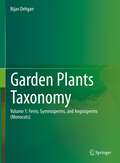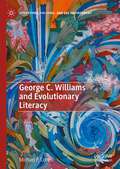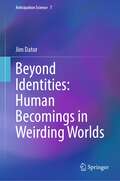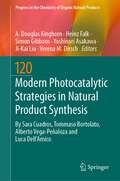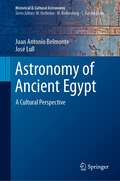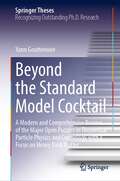- Table View
- List View
British Versions of Book II of Euclid’s Elements: Geometry, Arithmetic, Algebra (SpringerBriefs in History of Science and Technology)
by Leo CorryThis book discusses the changing conceptions about the relationship between geometry and arithmetic within the Euclidean tradition that developed in the British context of the sixteenth and seventeenth century. Its focus is on Book II of the Elements and the ways in which algebraic symbolism and methods, especially as recently introduced by François Viète and his followers, took center stage as mediators between the two realms, and thus offered new avenues to work out that relationship in idiosyncratic ways not found in earlier editions of the Euclidean text. Texts examined include Robert Recorde's Pathway to Knowledge (1551), Henry Billingsley’s first English translation of the Elements (1570), Clavis Mathematicae by William Oughtred and Artis Analyticae Praxis by Thomas Harriot (both published in 1631), Isaac Barrow’s versions of the Elements (1660), and John Wallis Treatise of Algebra (1685), and the English translations of Claude Dechales’ French Euclidean Elements (1685). This book offers a completely new perspective of the topic and analyzes mostly unexplored material. It will be of interest to historians of mathematics, mathematicians with an interest in history and historians of renaissance science in general.
Essentials of Autopsy Practice: Updates and Reviews to Aid Practice
by Guy N. RuttyThis book covers topical subjects within the field of death investigation, where changes in practice have recently occurred. The topics embrace the multi-disciplinary approach required for death investigation, and address advances in the fields of forensic fractography in relation to road traffic death investigations, pathology, MicroCt and 3D printing as applied to forensics. Chapters are written in a uniform easy-to-follow format to ensure they are accessible to both specialists and non-specialists in the field. Essentials of Autopsy Practice — Updates and Reviews to Aid Practice is a practical focused resource covering the latest advances in autopsy practice, making it an ideal resource for trainees, consultants, generalists and specialists, along with multi-disciplinary teams working in this field.
Forest Entomology and Pathology: Volume 1: Entomology
by Jeremy D. Allison Timothy D. Paine Bernard Slippers Michael J. WingfieldThis open access book will provide an introduction to forest entomology, the principles and techniques of forest insect pest management, the different forest insect guilds/feeding groups, and relevant forest insect pest management case studies. In addition to covering 30% of the earth, forest ecosystems provide numerous timber and non-timber products that affect our daily lives and recreational opportunities, habitat for diverse animal communities, watershed protection, play critical roles in the water cycle, and mitigate soil erosion and global warming. In addition to being the most abundant organisms in forest ecosystems, insects perform numerous functions in forests, many of which are beneficial and critical to forest health. Conversely, some insects damage and/or kill trees and reduce the capacity of forests to provide desired ecosystem services. The target audience of this book is upper-level undergraduate and graduate students and professionals interested in forest health and entomology.
Garden Plants Taxonomy: Volume 1: Ferns, Gymnosperms, and Angiosperms (Monocots)
by Bijan DehganHorticulture has remained far behind in understanding of botanical principles. Recent phylogenetic (DNA-based) reorganization of higher plants has revolutionized taxonomic treatments of all biological entities, even when morphology does not completely agree with their organization. This book is an example of applying principals of botanical phylogenetic taxonomy to assemble genera, species, and cultivars of 200 vascular plant families of ferns, gymnosperms, and angiosperms that are cultivated for enhancement of human living space; homes, gardens, and parks. The emphases are on cultivated species but examples of some plants are often shown in the wild and in landscapes. In providing descriptions, it is assumed that students and other interested individuals have no background in general botany (plant characteristics), or nomenclature. Fundamental features of all plant groups discussed are fully illustrated by original watercolor drawings or photographs. Discussion of the families is grounded on recent botanical phylogenetic treatments, which is based on common ancestry (monophyly). Of course, phylogenetic taxonomy is not a new concept, and was originally based on morphological characteristics; it is the DNA-based phylogeny that has revolutionized modern biological classifications. In practical terms, this book represents the horticultural treatment that corresponds to phylogenetic-based botanical taxonomy, to which is added cultigens and cultivated genera and species. Hence, the harmony between horticultural and botanical taxonomy. This book covers phylogenetic-based taxonomy of Ferns, Gymnosperms, and Angiosperms (Monocots). A companion volume covers Angiosperms (Eudicots).
Transforming Entrepreneurship Education: Interdisciplinary Insights on Innovative Methods and Formats
by Jantje Halberstadt Antonieta Alcorta de Bronstein Jean Greyling Shaun BissettThis open access book provides selected teaching approaches, supporting methods, concrete examples of curricula as well as extracurricular teaching formats, which are predominantly tailored to both African and German requirements. These approaches were developed by the YEEES Training and Research Centers, an international interdisciplinary network of university teachers and researchers from Germany and southern Africa, and combine the fields of management, entrepreneurship, information and communication technologies (ICT), and sustainability. The book shows how current scientific results can be integrated into teaching, how students can contribute to research while learning, and how research can contribute to the development and evaluation of new formats. It is thus relevant for university teachers, researchers, students as well as practitioners who want to educate and act as future change agents.
Biodiversity: Maintenance, Function, Origin, and Self-Organisation into Life-Support Systems
by Edmundas LekevičiusSpecies are not functionally independent. From a long-term perspective, only ecosystem with a fully integrated nutrient cycle is alive. The lack of trophic autonomy should be considered one of the key factors that ensure and maintain biodiversity. The variability of abiotic conditions, both in space and in time, also creates a huge diversity of niches and subniches for genotypes and species. In addition, life maintains its essential variables (biomass and productivity) as stable as possible due to the diversity of structures (genes, macromolecules, metabolic pathways, genotypes, species, etc.): the structures that reach optima are multiplied and thus activated, while the functioning of those which lost their optima is suppressed. The facts and concepts presented in this monograph thus support the conclusions that (a) genotype and species diversity is supported by trophic specialisation (b) biodiversity helps to stabilise the functions (essential variables) of individuals, populations, and ecological communities (c) in evolution, the emergence of biodiversity is determined by heritable variation and the advantage of specialised (more effective) structures over non-specialised ones (d) biodiversity is characterised by its ability to increase itself and to organise itself into relatively consistent structures, which we call production pyramids and nutrient cycles. This book therefore provides an answer to the question "why the diversity of life is of such and such a nature".
Climate Protection and Environmental Interests in Renewable Energy Law: Perspectives from Brazil and Germany
by Paula Galbiatti SilveiraThis book is about environmental and climate legal protection in the energy transition. The Paris Agreement has a binding commitment of holding the global temperature increase to 2°C while pursuing efforts to limit it to 1.5°C. To cope with the negative effects of climate changes and mitigate greenhouse gas emissions, one of the primary responses has been the deployment of renewable energy sources, transiting from fossil fuels to sustainable electricity production. However, renewable energy sources can also cause significant environmental impacts. Wind energy, for instance, can impact biodiversity, such as birds and bats, killing them when colliding with turbines and affecting their migration and nesting.This results in conflicts in environmental law. This book questions whether, in the energy transition, the generation of electricity from renewable sources to protect the climate is compatible with the protection of the environment, both interests in environmental law.To address this question, this book follows a legal-environmental perspective and assesses the common problem of solving those internal environmental conflicts in Brazilian and German law to understand and compare whether and how both legal systems solve the conflicts by compatibilizing the protection of the climate with other environmental interests. The legal analysis focuses on land-use planning and environmental licensing, assessing similarities and differences, and evaluating the results, identifying what one country can learn from the other.
George C. Williams and Evolutionary Literacy (Literatures, Cultures, and the Environment)
by Michael P. CohenIn this book, a case study of a humanistic reading of an essential evolutionary theorist, George C. Williams (May 12, 1926–September 8, 2010), the author contends that certain classic works of evolutionary theory and history are the most important nature writing of recent times. What it means to be scientifically literate—is essential for humanistic scholars, who must ground themselves with literary reading of scientific texts. As the most influential American evolutionary theorist of the second half of the twentieth century, Williams masters critique, frames questions about adaptation and natural selection, and answers in a plain, aphoristic writing style. Williams aims for parsimony—to “recognize adaptation at the level necessitated by the facts and no higher”—through a minimalist writing style. This voice articulates a powerful process that operates at very low levels by blind and selfish chance at the expense of its designed products, using purely trial and error.
Single Molecule Toroics: Synthetic Strategies, Theory and Applications
by Keith MurrayThis book consists of chapters written by international experts on various aspects of single molecule toroics (SMTs).The chapters cover a broad range of relevant topics and highlight the latest advances performed in the field. An up-to-date overview of the emerging SMT architectures is presented while particular attention is given to not only the magnetism and relaxation effects involved but also to the respective applications in advanced electronics and memory devices. The role that lanthanides play -especially that of dysprosium- is discussed, while a thorough analysis using theoretical/ab initio calculations is provided. Since SMTs have grown out of single molecule magnetism (SMM), it is an expanding and topical subject and the present book will engender excitement and interest amongst chemists, physicists, theoreticians and materials scientists. The volume will be of great interest to researchers and graduates working on this topic and particularly those involved in lanthanide chemistry, magnetism and theory.
Valuing the Past, Sustaining the Future?: Exploring Coastal Societies, Childhood(s) and Local Knowledge in Times of Global Transition (MARE Publication Series #27)
by Anne Trine Kjørholt Sharon Bessell Dympna Devine Firouz Gaini Spyros SpyrouThis book explores questions related to social and cultural sustainability of coastal communities in transition through the lens of childhood. Contributors explore diverse local and national contexts spanning several countries aiming to shed light on the shifting and dynamic interplay between education, knowledge production, society and working life in coastal environments from an intergenerational perspective. Key points that are disclosed are:the current threat to the social and cultural sustainability of coastal communities in different local and national contexts, and the reason they must be preserved the centrality of processes of inter generational transmission of local knowledge to the preservation and development of sustainable coastal communitiesthe central role of children and young people as actors in creating sustainable livelihoods, economies and knowledge in coastal communities for the future?the practices across different country contexts The book will address the challenges to sustainability experienced by local communities in light of local, national and global social and economic changes. Looking at these challenges cross-nationally and through the lens of childhood, and knowledge production across generations, will provide for a much-needed perspective in ongoing discussion on sustainability in coastal communities.
Guidelines for Laboratory Quality Managers (Integrating Food Science and Engineering Knowledge Into the Food Chain #14)
by Saverio ManninoThis useful and extensive set of guidelines is designed to assist food control laboratories in gaining accreditation from an internationally recognized external body, providing all of the necessary information and practices in an easy-to-read, step-by-step fashion. Authored by an experienced consultant for laboratory accreditation in many different countries, with this text food control lab owners now have all of the up-to-date information they need to gain accreditation in a single source. Guidelines for Laboratory Quality Managers covers the essentials for quality management in the food control laboratory, from testing processes to current quality management systems. The ISO standards for accreditation are extensively explored, including managerial requirements, organizational aspects, complaint handling procedures, internal audits, and sampling. An entire section is dedicated to the implementation of managerial and technical requirements from quality control to program monitoring and evaluation. Analysis selection, preparation, and validation is covered extensively, and an entire section is dedicated to basic statistics from data presentation to distribution. Each section comes with helpful tips for lab managers plus definitions and terms. Comprehensive, easy-to-use and up-to-date, Guidelines for Laboratory Quality Managers is the guide for accreditation for food control laboratories.
Beyond Identities: Human Becomings in Weirding Worlds (Anticipation Science #7)
by Jim DatorThis book is an argument for moving beyond culturally/historically/ethnically/biologically-grounded identity as the necessary foundation of an authentic self. It highlights examples of people who are attempting to inhabit identities they feel are more appropriate to themselves, by deploring the damage done via claims about authentic identity. The sole theme of this book is “becoming beyond identity”. We are not fixed human beings but rather perpetually-dynamic human becomings. As intelligence is enabled or recognized beyond the merely human, we should welcome our continuing evolution from homosapiens, sapiens, into many varieties of intelligences on Earth and the cosmos. This book builds from tiny ripples into a tsunami of examples from conventional identity studies, to Confucian human becomings, to apotemnophilia, to DIY biohacking, to cyborgs, to artilects, to hiveminds, to intelligence in animals, plants and fungi from the Holocene through the beginnings of the precarious, climate change-driven Anthropocene Epoch, with hints far beyond and throughout the cosmos. From a lifetime of work in future studies, anticipation science and space studies, the author balances frank tales of his own experiences and beliefs concerning his uncertain and fluid identities with those of others who tell their stories. In addition to material from academic and popular sources, a few poems further illuminate the scene.
Primates in Anthropogenic Landscapes: Exploring Primate Behavioural Flexibility Across Human Contexts (Developments in Primatology: Progress and Prospects)
by Tracie McKinney Siân Waters Michelle A. RodriguesThe field of primatology has expanded substantially in the last twenty years, particularly with regard to studies of primates in human-altered landscapes. This text aims to review the recent literature on anthropogenic (of human origin) influences on non-human primates, bringing an overview of this important area of primatology together for students. Chapters are grouped into three sections, representing the many ways anthropogenic activities affect primate populations. The first section, ‘Human Influences on Primate Habitat’, covers ways in which wild primates are affected by human actions, including forest fragmentation, climate change, and the presence of dogs. Section two, ‘Primates in Human-Dominated Landscapes’, looks at situations where non-human primates and humans share space; this includes primates in urban environments, primate tourism, and primates in agroecosystems. The final section, ‘Primates in Captivity’, looks at primate behaviour and welfare in captive situations, including zoos, the primate pet trade, and in entertainment.
Modern Photocatalytic Strategies in Natural Product Synthesis (Progress in the Chemistry of Organic Natural Products #120)
by A. Douglas Kinghorn Heinz Falk Simon Gibbons Yoshinori Asakawa Ji-Kai Liu Verena M. DirschThis book presents recent reports of total syntheses involving a photocatalytic reaction as a key step in the methodology. Modern photocatalysis has proven its generality for the development and functionalization of native functionalities. To date, the field has found broad applications in diverse research areas, including the total synthesis of natural products. Among the selected examples presented in this book, it highlights how the photocatalytic process proceeds in a highly chemo-, regio-, and stereoselective manner, thereby allowing the rapid access to structurally complex architectures under light-driven conditions.
Quantitative Models in Life Science Business: From Value Creation to Business Processes (SpringerBriefs in Economics)
by Jung Kyu Canci Philipp Mekler Gang MuThis open access book explores the field of life science business from a multidisciplinary perspective. Applying statistical, mathematical, game-theoretic, and data science tools to pharmaceutical and biotechnology business endeavors, the book describes value creation, value maintenance, and value realization in the life sciences as a sequence of processes using the quantitative language of applied mathematics. Written by experts from a variety of fields, the contributions illustrate the shift from a deterministic to a stochastic view of the processes involved, offering a new perspective on life sciences economics. The book covers topics such as valuing and managing intellectual property in life science, licensing in the pharmaceutical business, outsourcing pharmaceutical R&D, and stochastic modelling of a pharmaceutical supply chain. The book will appeal to scholars of economics and the life sciences, as well as to professionals in chemical and pharmaceutical industries.
Astronomy of Ancient Egypt: A Cultural Perspective (Historical & Cultural Astronomy)
by Juan Antonio Belmonte José LullThis book is a comprehensive reference on ancient Egyptian astronomy, one of the most important topics in historical astronomy. Written by two recognized specialists—one an astronomer trained in Egyptology and the other an Egyptologist trained in astronomy—it synthesizes and analyses the international body of research surrounding this ancient culture.The chapters in this work address all major topics in the field, including Egyptian cosmogony and worldview, timekeeping devices and calendars, landscapes and skyscapes, astronomy-influenced architecture, chronology and more. Each chapter includes an introduction, an overview of the existing documentation on the subject, a critical discussion of ongoing debates and questions, and a presentation of state-of-the-art research.Straddling the line between Egyptology and astronomy, this multidisciplinary book will appeal to any scholar or specialist interested in studying ancient Egyptian astronomy.
Nuclear Receptors in Human Health and Disease (Advances in Experimental Medicine and Biology #1390)
by Moray J. Campbell Charlotte L. BevanThis book addresses and dissects the roles and crosstalk mechanisms for the 48 human nuclear receptors (NR) in human health and disease. After a State-of-the-Art introduction by an undisputed and celebrated field leader to provide an overview of the field and its significance, chapters are organized into six sections. The first three sections discuss NR roles in Reproduction & Development, Metabolism and Central Systems. These present to the reader our current understanding of NR signaling in the development and functioning of the reproductive system; the roles in the regulation of energy metabolism; and how NR signaling is more widely integrated into systemic functions from calcium flux to circadian rhythm. The subsequent three sections dissect how aberrant NR functions drive Cancer; how new insights into Genomic Interaction are helping to reveal how NR disruption drives disease; and finally, how Translational Efforts are exploiting this understanding from developing novel NR ligands to establishing how underlying genetic variation impacts NR function. Within these sections the chapters also illustrate emerging understanding of how the epigenome and non-coding genome combine to regulate NR function and impact dysfunction. Increasingly these insights cross-fertilize over cell and disease boundaries and it is unsurprising that NR are being explored in novel and new arenas such as the context of neurological disorders and depression. Thus, there is wide scope for re-purposing of licensed drugs and development of new NR-targeting therapies for a host of conditions and diseases. This unique book brings together many of the leading figures in NR research from across the globe, to discuss emerging roles and their implications for human health and disease. It summarizes the state of the art and shows signposts for future research to further shape this influential field.
Beyond the Standard Model Cocktail: A Modern and Comprehensive Review of the Major Open Puzzles in Theoretical Particle Physics and Cosmology with a Focus on Heavy Dark Matter (Springer Theses)
by Yann GouttenoireThis book provides a remarkable and complete survey of important questions at the interface between theoretical particle physics and cosmology.After discussing the theoretical and experimental physics revolution that led to the rise of the Standard Model in the past century, the author reviews all the major open puzzles, among them the hierarchy problem, the small value of the cosmological constant, the matter-antimatter asymmetry, and the dark matter enigma, including the state-of-the-art regarding proposed solutions. Also addressed are the rapidly expanding fields of thermal dark matter, cosmological first-order phase transitions and gravitational-wave signatures. In addition, the book presents the original and interdisciplinary PhD research work of the author relating to Weakly-Interacting-Massive-Particles around the TeV scale, which are among the most studied dark matter candidates. Motivated by the absence of experimental evidence for such particles, this thesis explores the possibility that dark matter is much heavier than what is conventionally assumed.
Phononic and Electronic Excitations in Complex Oxides Studied with Advanced Infrared and Raman Spectroscopy Techniques (Springer Theses)
by Fryderyk LyzwaThis PhD thesis reports on investigations of several oxide-based materials using advanced infrared and Raman spectroscopy techniques and in combination with external stimuli such as high magnetic or electric field, sptial confinement in thin film heterostructures and the radiation with UV light. This leads to new results in the fields of superconductivity, electronic polarization states and nanoscale phenomena.Among these, the observation of anomalous polar moments is of great relevance for understanding the electric-field-induced metal-to-insulator transistion; and the demonstration that confocal Raman spectroscopy of backfolded acoustic photons in metal-oxide multilayers can be used as a powerful characterization tool for monitoring their interface properties and layer thickness is an important technical development for the engineering of such functional oxide heterostructures.
Space and Astrophysical Plasma Simulation: Methods, Algorithms, and Applications
by Jörg BüchnerThis book is a collection of contributions covering the major subjects in numerical simulation of space and astrophysical plasma. It introduces the different approaches and methods to model plasma, the necessary computational codes, and applications in the field. The book is rooted in the previous work Space Plasma Simulation (Springer, 2003) and includes the latest developments. It is divided into three parts and all chapters start with an introduction motivating the topic and its use in research and ends with a discussion of its applications. The chapters of the first part contain tutorials of the different basic approaches needed to perform space plasma simulations. This part is particularly useful for graduate students to master the subject. The second part presents more advanced materials for students and researchers who already work with pre-existing codes but want to implement the recent progresses made in the field. The last part of the book discusses developments in the area for researchers who are actively working on advanced simulation approaches like higher order schemes and artificial intelligence, agent-based technologies for multiscale and multi-dimensional systems, which represent the recent innovative contributions made in space plasma research.
Image-Based Teaching: Techniques, Tips and Tricks
by Tara CatanzanoThis book offers detailed information on a variety of teaching techniques for radiology. Generational differences in communication and adult learning theory have led to changes in educational content delivery. Traditional didactic teaching methods are no longer embraced by students, requiring educators to learn and adopt new techniques. Radiologists currently in practice have little or no experience with these newer techniques, some thrust upon them abruptly by the COVID pandemic. In addition to practicing radiologists, the next generation of educators are currently in training and often do not receive instruction on educational theory and teaching techniques. It is incumbent upon members of the educational sphere to provide resources for these individuals. This work intends to provide just such a resource.The objectives of the book include: Explaining adult learning theory and brain-friendly teachingDescribing teaching techniques to leverage brain-friendly teachingReinforcing key points with links to online video-based lectures as an accompaniment to the text Topics covered across chapters include helping non-teaching faculty to teach, writing high quality MCQ questions, and teaching quality, safety, and professionalism. Each chapter will have one “key takeaway” chart at the conclusion of the chapter with high-yield key points highlighted in a bulleted format.This is an ideal guide for practicing radiologists, including those not currently working in academic centers. Faculty in non-academic centers can specifically benefit from chapters related to medical student, clinician and patient education. Future academic radiologists (i.e., fellows and residents) can benefit from the text as a foundation for careers in teaching hospitals and academic medical centers.
Pioneers in Cell Physiology: The Story of Warren and Margaret Lewis (Perspectives in Physiology)
by David H. EvansThis monograph is dedicated to the lives and scientific achievements of the physiology pioneers Warren and Margaret Lewis. Their story spans the first half of the 20th century, from their respective educations through early, independent research to joint research from 1910 to 1955. Among the numerous developments they initiated, were the discovery of pinocytosis, the beginnings of video microscopy and the development of the first mammalian tissue cultures. Their research expanded the theoretical knowledge of cell structure and function. On a more practical level, they advanced many laboratory methods, like the first recipes for culture media. The text is beautifully enriched with personal anecdotes about their lives. This is the story of two scientific pioneers in the context of early 20th century biology and physiology. It is an inspiration for senior and aspiring researchers.
Models for Research and Understanding: Exploring Dynamic Systems, Unconventional Approaches, and Applications (Simulation Foundations, Methods and Applications)
by Stanislaw RaczynskiThis introductory textbook/reference addresses the fundamental and mostly applied kinds of models. The focus is on models of dynamic systems that move and change over time. However, the work also proposes new methods of uncertainty treatment, offering supporting examples.Topics and features: Chapters suitable for textbook use in teaching modeling and simulationIncludes sections of questions and answers, helpful in didactic workProposes new methodology in addition to examining conventional approachesOffers some cognitive, more abstract models to give a wider insight on model building The book’s readership may consist of researchers working on multidisciplinary problems, as well educators and students. It may be used while teaching computer simulation, applied mathematics, system analysis and system dynamics.
MR Enterography: Crohn’s Disease and Beyond
by Silvio Mazziotti Alfredo Blandino Giuseppe CiceroThis second edition is primarily dedicated to MR-Enterography, an imaging modality whose reliability for intestinal assessment in patients suffering from inflammatory bowel diseases has gained increasing consensus.The performance of this technique has been significantly enlarged over the last years, due to its undoubted advantages in terms of exhaustive evaluation of the abdominal cavity and safeness due to the lack of radiation exposure. The first part is focused on MR-Enterography standard protocol. Nevertheless, additional sequences, technical novelties and common pitfalls are reported and discussed. In the second section, the typical intestinal and extra-intestinal findings related to Crohn’s disease are described in detail. In this edition, more emphasis has been put on practical topics, useful in the daily clinical practice: anatomical changes after surgical procedures, structured reporting and emerging clinical applications over inflammatory bowel diseases.Another part is dedicated to Magnetic Resonance Imaging of the anal canal, including technical aspects and clinical implications.The text is largely complemented by diagnostic images. Nonetheless, at the end of the book 30 illustrated cases show different clinical scenarios evaluated with MR-Enterography and Magnetic Resonance Imaging of the anal canal.



